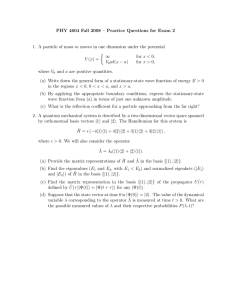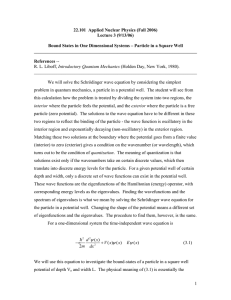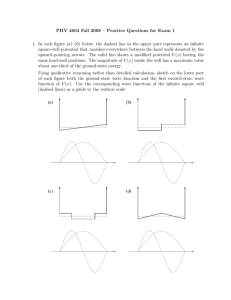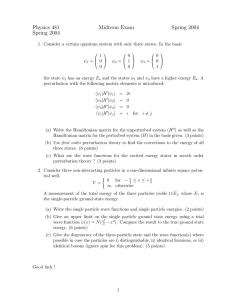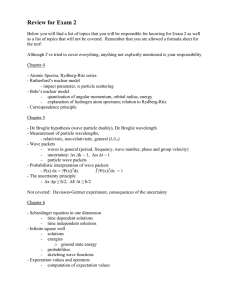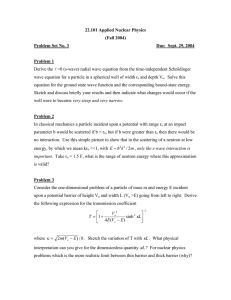22.101 Applied Nuclear Physics (Fall 2004) Lecture 3 (9/15/04)
advertisement
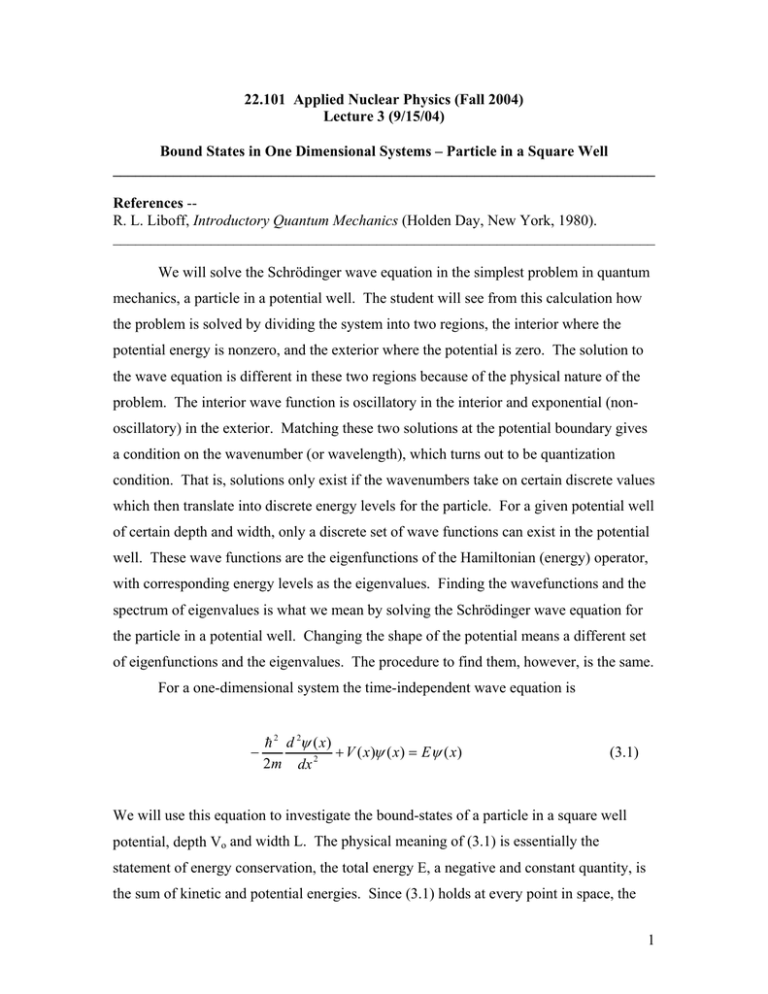
22.101 Applied Nuclear Physics (Fall 2004) Lecture 3 (9/15/04) Bound States in One Dimensional Systems – Particle in a Square Well ________________________________________________________________________ References -R. L. Liboff, Introductory Quantum Mechanics (Holden Day, New York, 1980). ________________________________________________________________________ We will solve the Schrödinger wave equation in the simplest problem in quantum mechanics, a particle in a potential well. The student will see from this calculation how the problem is solved by dividing the system into two regions, the interior where the potential energy is nonzero, and the exterior where the potential is zero. The solution to the wave equation is different in these two regions because of the physical nature of the problem. The interior wave function is oscillatory in the interior and exponential (non­ oscillatory) in the exterior. Matching these two solutions at the potential boundary gives a condition on the wavenumber (or wavelength), which turns out to be quantization condition. That is, solutions only exist if the wavenumbers take on certain discrete values which then translate into discrete energy levels for the particle. For a given potential well of certain depth and width, only a discrete set of wave functions can exist in the potential well. These wave functions are the eigenfunctions of the Hamiltonian (energy) operator, with corresponding energy levels as the eigenvalues. Finding the wavefunctions and the spectrum of eigenvalues is what we mean by solving the Schrödinger wave equation for the particle in a potential well. Changing the shape of the potential means a different set of eigenfunctions and the eigenvalues. The procedure to find them, however, is the same. For a one-dimensional system the time-independent wave equation is − h 2 d 2ψ (x) + V (x)ψ (x) = Eψ (x) 2m dx 2 (3.1) We will use this equation to investigate the bound-states of a particle in a square well potential, depth Vo and width L. The physical meaning of (3.1) is essentially the statement of energy conservation, the total energy E, a negative and constant quantity, is the sum of kinetic and potential energies. Since (3.1) holds at every point in space, the 1 fact that the potential energy V(x) varies in space means the kinetic energy of the particle also will vary in space. For a square well potential, V(x) has the form V (x) = −Vo = 0 − L/2 ≤ x ≥ L/2 elsewhere (3.2) as shown in Fig. 1. Taking advantage of the piecewise constant behavior of the potnetial, Fig. 1. The square well potential centered at the origin with depth Vo and width L. we divide the configuration space into an interior region, where the potential is constant and negative, and an exterior region where the potential vanishes. For the interior region the wave equation can be put into the standard form of a second-order differential equation with constant coefficient, d 2ψ (x) + k 2ψ (x) = 0 2 dx x ≤ L/2 (3.3) where we have introduced the wavenumber k such that k 2 = 2m( E + Vo ) / h 2 is always positive, and therefore k is always real. For this to be true we are excluding solutions where –E > Vo. For the exterior region, the wave equation similarly can be put into the form 2 d 2ψ (x) − κ 2ψ (x) = 0 2 dx x ≥ L/2 (3.4) where κ 2 = −2mE / h 2 . To obtain the solutions of physical interest to (3.3) and (3.4), we keep in mind that the solutions should have certain symmetry properties, in this case they should have definite parity, or inversion symmetry (see below). This means when x → -x, ψ (x) must be either invariant or it must change sign. The reason for this requirement is that the Hamiltonian H is symmetric under inversion (potential is symmetric with our choice of coordinate system (see Fig. 1). Thus we take for our solutions ψ (x) = Asin kx x ≤ L/2 = Be −κx x > L/2 = Ce κx x < -L/2 (3.5) We have used the condition of definite parity in choosing the interior solution. While we happen to have chosen a solution with odd parity, the even-parity solution, coskx, would be just as acceptable. On the other hand, one cannot choose the sum of the two, Asinkx + Bcoskx, since this does not have definite parity. For the exterior region we have applied condition (i) in Lec2 to discard the exponentially growing solution. This is physically intuitive since for a bound state the particle should be mostly inside the potential well, and away from the well the wave function should be decaying rather than growing. In the solutions we have chosen there are three constants of integration, A, B, and C. These are to be determined by applying boundary conditions at the interface between the interior and exterior regions, plus a normalization condition (2.23). Notice there is another constant in the problem which has not been specified, the energy eigenvalue E. All we have said thus far is that E is negative. We have already utilized the boundary condition at infinity and the inversion symmetry condition of definite parity. The 3 condition which we can now apply at the continuity conditions (ii) and (iii) in Lec2. At the interface, xo = ± L / 2 , the boundary conditions are ψ int (xo ) = ψ ext (xo ) dψ int (x) dx = xo dψ ext (x) dx (3.6) (3.7) xo with subscripts int and ext denoting the interior and exterior solutions respectively. The four conditions at the interface do not allow us to determine the four constants because our system of equations is homogeneous. As in situations of this kind, the proportionality constant is fixed by the normalization condition (2.23). We therefore obtain C = -B, B = Asin(kL / 2) exp(κL / 2) , and cot(kL / 2) = −κ / k (3.8) with the constant A determined by (2.23). The most important result of this calculation is (3.8), sometimes also called a dispersion relation. It is a relation which determines the allowed values of E, a quantity that appears in both k and κ . These are then the discrete (quantized) energy levels which the particle can have in the particular potential well given, namely, a square well of width L and depth Vo. Eq.(3.8) is the consequence of choosing the odd-parity solution for the interior wave. For the even-parity solution, ψ int (x) = A' cos kx , the corresponding dispersion relation is tan(kL / 2) = κ / k (3.9) Since both solutions are equally acceptable, one has two distinct sets of energy levels, given (3.8) and (3.9). We now carry out an analysis of (3.8) and (3.9). First we put the two equations into dimensionless form, 4 ξ cot ξ = −η (odd-parity) (3.10) ξ tan ξ = η (even-parity) (3.11) where ξ = kL / 2 , η = κL / 2 , and ξ 2 + η 2 = 2mL2 Vo / 4h 2 ≡ Λ (3.12) is a constant for fixed values of Vo and L. In Fig. 4 we plot the left- and right-hand sides of (3.10) and (3.11), and obtain from their intersections the allowed energy levels. The graphical method of obtaining solutions to the dispersion relations reveals the following Fig. 4. Graphical solutions of (3.10) and (3.11) showing that there could be no odd- parity solutions if Λ is not large enough (the potential is not deep enough or not wide enough), while there is at least one even-parity solution no matter what values are the well depth and width. features. There exists a minimum value of Λ below which no odd-parity solutions are allowed. On the other hand, there is always at least one even-parity solution. The first even-parity energy level occurs at ξ < π / 2 , whereas the first odd-parity level occurs at 5 π / 2 < ξ < π . Thus, the even- and odd-parity levels alternate in magnitudes, with the lowest level being even in parity. We should also note that the solutions depend on the potential function parameters only through the variable Λ , or the combination VoL2, so that changes in well depth have the same effect as changes in the square of the well width. At this point it is well to keep in mind that when we consider problems in three dimensions (next chapter), the cosine solution to the wave function has to be discarded because of the condition of regularity (wave function must be finite) at the origin. This means that there will be a minimum value of Λ or VoL2 below which no bound states can exist. We now summarize our results for the allowed energy levels of a particle in a square well potential and the corresponding wave functions. ψ int (x) = Asin kx or A' cos kx ψ ext (x) = Be −κx = Ce κx x < L/2 (3.13) x > L/2 x < -L/2 (3.14) where the energy levels are h2k 2 h 2κ 2 =− E = − Vo + 2m 2m (3.15) The constants B and C are determined from the continuity conditions at the interface, while A and A’ are to be fixed by the normalization condition. The discrete values of the bound-state energies, k or κ , are obtained (3.8) and (3.9). In Fig. 5 we show a sketch of the two lowest-level solutions, the ground state with even-pairty and the first excited state with odd parity. Notice that the number of excited states that one can have depends on 6 Fig. 5. Ground-state and first two excited-state solutions [from Cohen, p. 16] the value of Vo because our solution is valid only for negative E. This means that for a potential of a given depth, the particle can be bound only in a finite number of states. To obtain more explicit results it is worthwhile to consider an approximation to the boundary condition at the interface. Instead of the continuity of ψ and its derivative at the interface, one might assume that the penetration of the wave function into the external region can be neglected and require that ψ vanishes at x = ± L / 2 . Applying this condition to (3.13) gives kL = nπ , where n is any integer, or equivalently, E n = − Vo + n 2π 2 h 2 , 2mL2 n = 1, 2, … (3.16) This shows explicitly how the energy eigenvalue En varies with the level index n, which is the quantum number. The corresponding wave functions are ψ n (x) = An cos(nπx / L) , n = 1, 3, … = An' sin(nπx / L) n = 2, 4, … (3.17) The first solutions in this approximate calculation are also shown in Fig. 5. We see that requiring the wave function to vanish at the interface is tantamount to assuming that the particle is confined in a well of width L and infinitely steep walls (the infinite well 7 potential or limit of Vo → ∞ ). It is therefore to be expected that the problem becomes independent of Vo and there is no limit on the number of excited states. Clearly, the approximate solutions become the more useful the greater is the well depth, and the error is always a higher energy level as a result of squeezing of the wave function (physically, the wave has a shorter period or a larger wavenumber). 8

